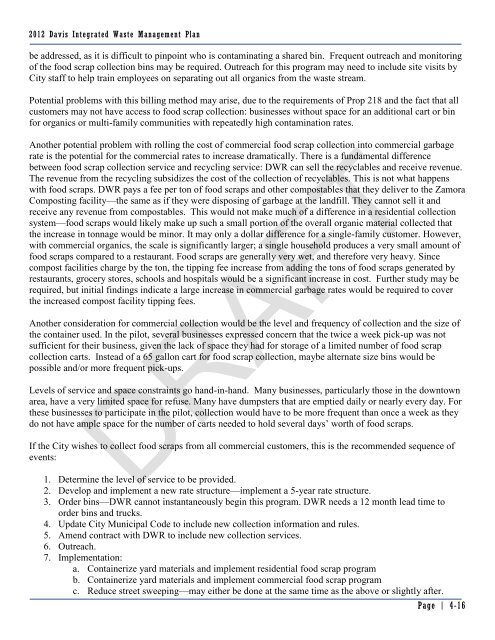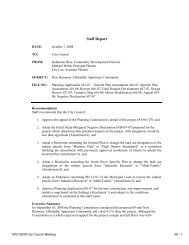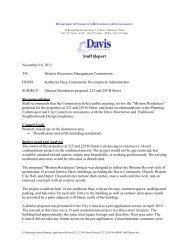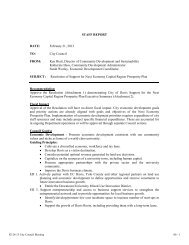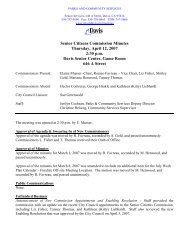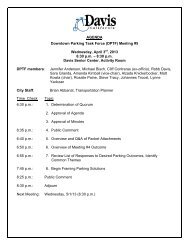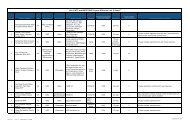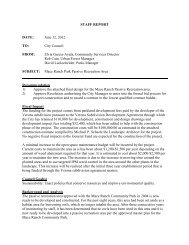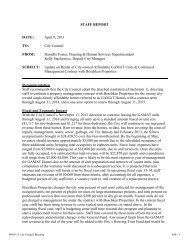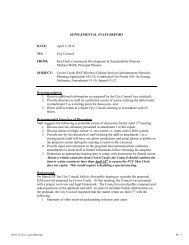10 Draft Integrated Waste Management Plan - City Council - City of ...
10 Draft Integrated Waste Management Plan - City Council - City of ...
10 Draft Integrated Waste Management Plan - City Council - City of ...
Create successful ePaper yourself
Turn your PDF publications into a flip-book with our unique Google optimized e-Paper software.
2012 Davis <strong>Integrated</strong> <strong>Waste</strong> <strong>Management</strong> <strong>Plan</strong><br />
be addressed, as it is difficult to pinpoint who is contaminating a shared bin. Frequent outreach and monitoring<br />
<strong>of</strong> the food scrap collection bins may be required. Outreach for this program may need to include site visits by<br />
<strong>City</strong> staff to help train employees on separating out all organics from the waste stream.<br />
Potential problems with this billing method may arise, due to the requirements <strong>of</strong> Prop 218 and the fact that all<br />
customers may not have access to food scrap collection: businesses without space for an additional cart or bin<br />
for organics or multi-family communities with repeatedly high contamination rates.<br />
Another potential problem with rolling the cost <strong>of</strong> commercial food scrap collection into commercial garbage<br />
rate is the potential for the commercial rates to increase dramatically. There is a fundamental difference<br />
between food scrap collection service and recycling service: DWR can sell the recyclables and receive revenue.<br />
The revenue from the recycling subsidizes the cost <strong>of</strong> the collection <strong>of</strong> recyclables. This is not what happens<br />
with food scraps. DWR pays a fee per ton <strong>of</strong> food scraps and other compostables that they deliver to the Zamora<br />
Composting facility—the same as if they were disposing <strong>of</strong> garbage at the landfill. They cannot sell it and<br />
receive any revenue from compostables. This would not make much <strong>of</strong> a difference in a residential collection<br />
system—food scraps would likely make up such a small portion <strong>of</strong> the overall organic material collected that<br />
the increase in tonnage would be minor. It may only a dollar difference for a single-family customer. However,<br />
with commercial organics, the scale is significantly larger; a single household produces a very small amount <strong>of</strong><br />
food scraps compared to a restaurant. Food scraps are generally very wet, and therefore very heavy. Since<br />
compost facilities charge by the ton, the tipping fee increase from adding the tons <strong>of</strong> food scraps generated by<br />
restaurants, grocery stores, schools and hospitals would be a significant increase in cost. Further study may be<br />
required, but initial findings indicate a large increase in commercial garbage rates would be required to cover<br />
the increased compost facility tipping fees.<br />
Another consideration for commercial collection would be the level and frequency <strong>of</strong> collection and the size <strong>of</strong><br />
the container used. In the pilot, several businesses expressed concern that the twice a week pick-up was not<br />
sufficient for their business, given the lack <strong>of</strong> space they had for storage <strong>of</strong> a limited number <strong>of</strong> food scrap<br />
collection carts. Instead <strong>of</strong> a 65 gallon cart for food scrap collection, maybe alternate size bins would be<br />
possible and/or more frequent pick-ups.<br />
Levels <strong>of</strong> service and space constraints go hand-in-hand. Many businesses, particularly those in the downtown<br />
area, have a very limited space for refuse. Many have dumpsters that are emptied daily or nearly every day. For<br />
these businesses to participate in the pilot, collection would have to be more frequent than once a week as they<br />
do not have ample space for the number <strong>of</strong> carts needed to hold several days’ worth <strong>of</strong> food scraps.<br />
DRAFT<br />
If the <strong>City</strong> wishes to collect food scraps from all commercial customers, this is the recommended sequence <strong>of</strong><br />
events:<br />
1. Determine the level <strong>of</strong> service to be provided.<br />
2. Develop and implement a new rate structure—implement a 5-year rate structure.<br />
3. Order bins—DWR cannot instantaneously begin this program. DWR needs a 12 month lead time to<br />
order bins and trucks.<br />
4. Update <strong>City</strong> Municipal Code to include new collection information and rules.<br />
5. Amend contract with DWR to include new collection services.<br />
6. Outreach.<br />
7. Implementation:<br />
a. Containerize yard materials and implement residential food scrap program<br />
b. Containerize yard materials and implement commercial food scrap program<br />
c. Reduce street sweeping—may either be done at the same time as the above or slightly after.<br />
Page | 4-16


